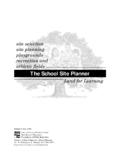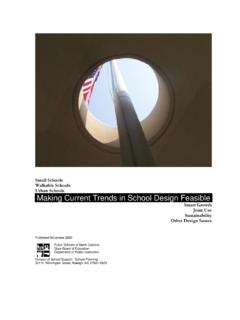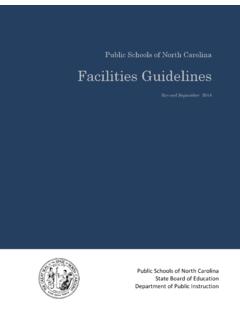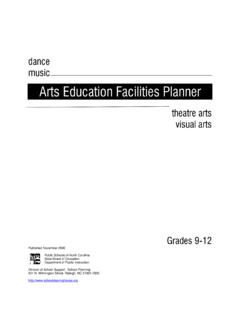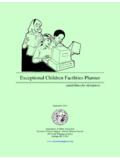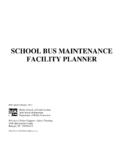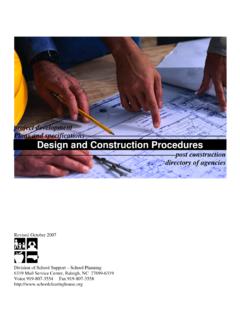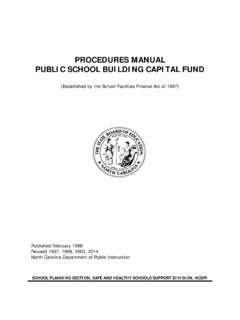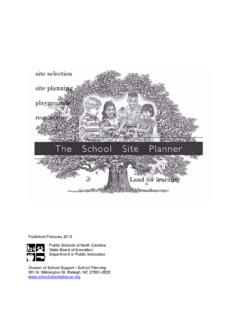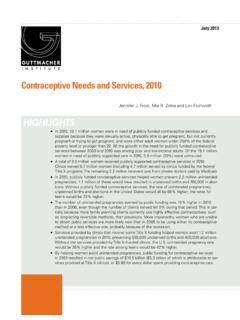Transcription of The Development of EDUCATIONAL SPECIFICATIONS
1 The Development of EDUCATIONAL SPECIFICATIONS Published November 2002 Public Schools of North Carolina State Board of Education Department of Public Instruction Division of School Support - School Planning 6322 Mail Service Center, Raleigh, NC 27699-6322 i FOREWORD Once the decision to construct a new EDUCATIONAL facility or to construct a major addition or renovation to an existing facility has been made, the first and perhaps most important step in the process of providing a facility that truly enhances the EDUCATIONAL program is the Development of EDUCATIONAL SPECIFICATIONS . With the approval of the board of education and with the assistance of staff and selected others, the superintendent of schools must assume the responsibility for the organization and supervision of the EDUCATIONAL SPECIFICATIONS project, as well as serve as liaison between the board of education, school staff, and the citizens of the community.
2 The above paragraph was taken from the PREFACE of the earlier publication entitled, The Development of EDUCATIONAL SPECIFICATIONS , published by School Planning in 1975. This paragraph and much of the content of the earlier publication are still valid. This publication is an attempt to update the earlier version and yet keep the basic organization of the information and the content that still applies intact. The earlier version was distributed in draft form to many North Carolina public school facility planners and educators and higher education professors teaching EDUCATIONAL administration graduate courses for comments and suggestions. By the internet, we can today solicit input you may have that will enable us to further improve this publication and make the EDUCATIONAL SPECIFICATIONS process an even better tool to help architects and engineers to design schools that enhance the education of students in our state.
3 Phillip J. Kirk, Jr., Chair Michael E. Ward, State Superintendent State Board of Education North Carolina Department of Public Instruction In compliance with federal law, including the provisions of Title IX of the Education Amendments of 1972, N C Public Schools administers all state-operated EDUCATIONAL programs, employment activities and admissions without discrimination because of race, religion, national or ethnic origin, color, age, military service, disability, or gender, except where exemption is appropriate and allowed by law. ii iii ACKNOWLEDGEMENTS The Department of Public Instruction gratefully acknowledges the contributions of the following, without which the Development of this publication would have been difficult.
4 Roger Ballard, AIA, Consulting Architect, School Planning Section, North Carolina Department of Public Instruction, Raleigh, NC. Eleanor Dixon, Administrative Assistant, School Planning Section, North Carolina Department of Public Instruction, Raleigh, NC. David Edwards, , Education Consultant, School Planning Section, North Carolina Department of Public Instruction, Raleigh, NC. Jim Lora, Consulting Architect, School Planning Section, North Carolina Department of Public Instruction, Raleigh, NC. Jerry Knott, AIA, Chief, School Planning Section, North Carolina Department of Public Instruction, Raleigh, NC. Steve Taynton, Consulting Architect, School Planning Section, North Carolina Department of Public Instruction, Raleigh, NC.
5 Author of the original document: Dr. Douglas L. Pearson, Education Consultant (retired), Division of School Planning iv v CONTENTS Part What Are EDUCATIONAL Sepcifications?..3 Why Develop EDUCATIONAL SPECIFICATIONS ?..3 Who Should Be Involved?..4 What Are the General Responsibilities of Those Involved?..6 How Should the EDUCATIONAL SPECIFICATIONS Document be Organized?..8 How Are EDUCATIONAL SPECIFICATIONS Developed?..8 Part Introduction and Background General Design EDUCATIONAL Activities and User Appendix A EDUCATIONAL SPECIFICATIONS Sub Committee Appendix B Planning Publications and Planning Guidelines Available from School vi 1 INTRODUCTION This publication has been developed to assist local boards of education, superintendents, and staff in the organization and Development of EDUCATIONAL SPECIFICATIONS .
6 The responsibility for programming a new EDUCATIONAL facility that may affect thousands of students and may cost in the millions of dollars is both an exciting and an humbling experience. In many instances, this challenge and, at the same time, wonderful opportunity, becomes the responsibility of educators who have had little or no experience with the EDUCATIONAL SPECIFICATIONS process or the product. This guide was developed because most educators have little knowledge concerning either the purpose, the process, the organization, or the contents of the finished product called EDUCATIONAL SPECIFICATIONS . The organization of this publication provides both a conceptual background and a suggested organizational framework for the content of the completed document.
7 Part I attempts to present a conceptual and operating primer on what EDUCATIONAL SPECIFICATIONS are; why they are developed; how they are organized; and who should be involved and how. Basically, Part I answers the questions What? Why? Who? and How? Part II is designed to provide more specific information relative to the organization and content of the EDUCATIONAL SPECIFICATIONS document. In the past, the quality and quantity of the SPECIFICATIONS content have varied greatly. Size has varied from two pages to several hundred pages; either extreme is ineffective for obvious reasons. The intent of Part II is to provide a skeleton for the SPECIFICATIONS that will permit a high degree of flexibility for adaptation to the variations of local situations while, at the same time, providing sufficient guidance for the bewildered educator who doesn=t know where to start.
8 2 Part I Part I contains general information about EDUCATIONAL SPECIFICATIONS - the purpose, the process, the personnel, and the product. Participating in the Development of EDUCATIONAL SPECIFICATIONS is both a challenge and a privilege that only a few people have the opportunity to experience. It is also a serious responsibility when one considers the many students and teachers who will be affected over the 50-year life expectancy of a school facility. Whether the facility will have a positive, neutral, or negative effect on the EDUCATIONAL process will depend to a large degree upon how effectively the EDUCATIONAL SPECIFICATIONS committee functions. The information contained in Part I is introductory and explanatory in nature.
9 An attempt has been made to provide answers to the following questions: C What are EDUCATIONAL SPECIFICATIONS ? C Why develop EDUCATIONAL SPECIFICATIONS ? C Who should be involved? C What are the general responsibilities of those involved? C How should the EDUCATIONAL SPECIFICATIONS document be organized? C How are EDUCATIONAL SPECIFICATIONS developed? 3 WHAT ARE EDUCATIONAL SPECIFICATIONS ? DEFINITION EDUCATIONAL SPECIFICATIONS may be defined as a written means of communication between educators and design professionals. Through this medium educators describe the EDUCATIONAL program and identify factors which affect learning and teaching, thus providing a data base for the architect to use in creating the building plans and SPECIFICATIONS .
10 CHARACTERISTICS Some characteristics of EDUCATIONAL SPECIFICATIONS are: C They are the responsibility of the educators. C They should be based on a predetermined EDUCATIONAL program. C They should state the educators' concept of facility and program needs and leave methods of satisfying the needs to the design professionals. C They should be free of rigid prescriptions. They are concise and to the point. C They are best developed through the involvement of educators, and community representatives. WHY DEVELOP EDUCATIONAL SPECIFICATIONS ? MEANS OF COMMUNICATION The primary purpose for developing EDUCATIONAL SPECIFICATIONS is to provide an effective means of communication between the EDUCATIONAL agency and the design professions.
